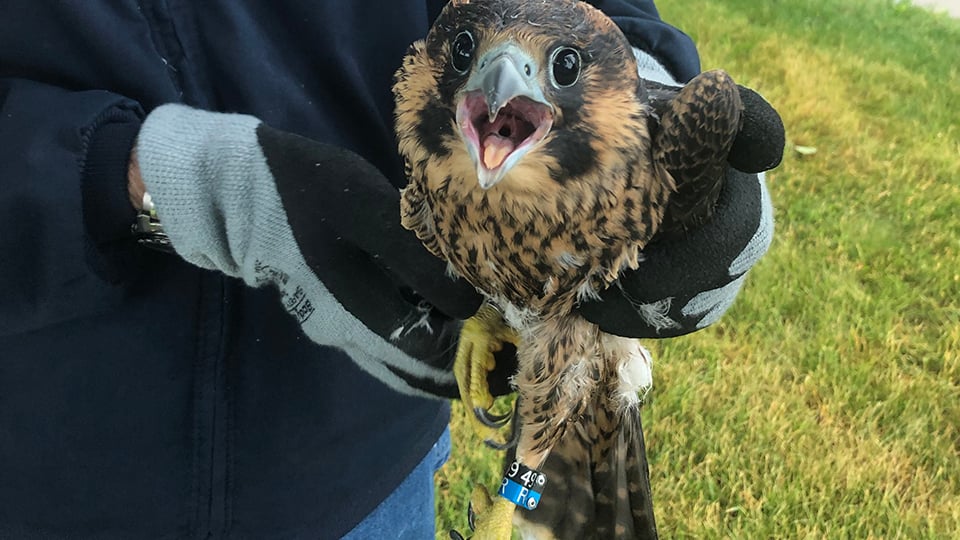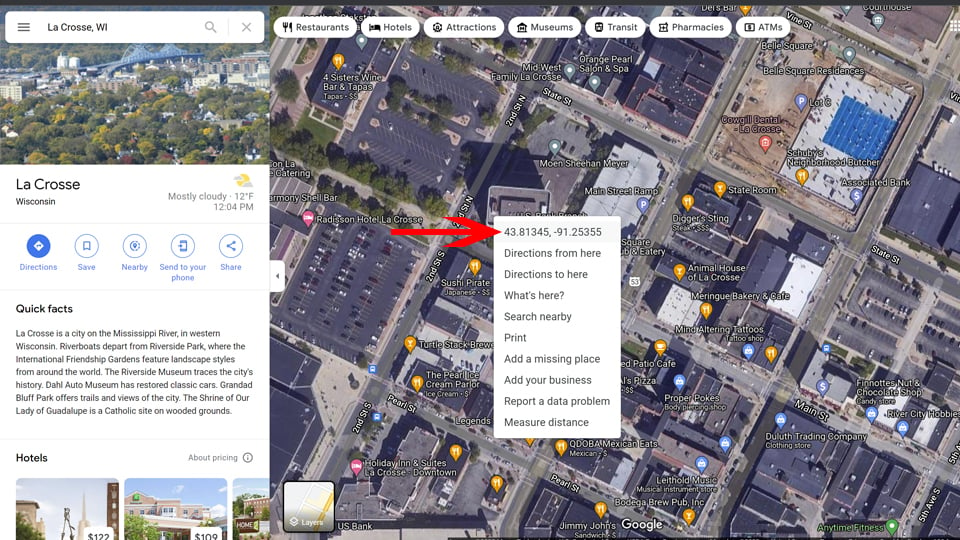We saw two falcons at Great Spirit Bluff over the weekend: an unbanded female and a banded black/red male. We don’t know who they were, although the black/red male wasn’t Newman. Did they originate north of Great Spirit Bluff or wander up from La Crosse, a little over five miles downstream? Without band numbers, we can’t know for sure, but eBird can help us explore wintering peregrines in La Crosse!
Ebird Reports
Between 2002 and 2021, bird watchers reported fifteen sightings of peregrine falcons in La Crosse during the winter: six at the US Bank building, five elsewhere in La Crosse, and four with no specific location. None of the reports include band numbers, so we don’t know whether they were locals. But it seems likely that at least some of them were: peregrine falcons nest on the US Bank Building, La Crosse is filled with prey, and the dam ensures open water and a steady supply of waterfowl. Staying gives residents an advantage over interlopers – if a territorial pair is already on site when falcons start migrating north, interlopers are more likely to move on!
Thanks to eBird we know that peregrine falcons winter in La Crosse, even if we don’t know who they are. If you’d like to see the map I used, follow this link: Wintering Peregrine Falcons in La Crosse, WI.
Who are the falcons at US Bank?
Thanks to US Bank’s new nest cam, we know that the resident male is 09/D Riley (black/red) and the resident female is 41/P Ostria (black/blue), a 2016 hatch from the Alliant Lansing Bluff. I thought it was interesting that the male falcon at Great Spirit Bluff appeared to have a black/red band. Again, GSB is only about five miles northwest of US Bank and we’ve seen falcons at both sites before. We don’t know who the unbanded female was, but maybe Riley was stretching his wings. It’s worth noting that there doesn’t seem to be any courting in this video – when the unknown male sees the female coming in, he immediately takes off.
Reading and Reporting Band Numbers
If you spot a band number on any of our sites, please record and report it! Peregrine falcons in the Midwest wear two bands: a federal aluminum band on their right leg and a colored auxiliary band on their left leg.
- The federal band is engraved with a nine-digit number. The prefix consists of four numbers, followed by a dash, followed by five more numbers. The prefix will end in a six (male falcons wear a 6B band) or a seven (female and unknown falcons wear a 7A band).
- The color or auxiliary band is striped. In the Midwest, the top color is black and the bottom color is blue, red, or green. The characters on the black/top band are read first, followed by the characters on the color/bottom band. The number is expressed as X/Y, so the band below is read as 49/R.

Peregrine falcon 49/R
- If one of the characters is on its side, add an asterisk. If R was on its side, the band number above would be 49/*R, not 49/R.
Once you have the color band number, go to the Midwest Peregrine falcon database at https://midwestperegrine.umn.edu/?vw=search. Enter the band number and band color, and click ‘Preview Results‘ to learn more about the bird’s age, sex, origin, federal band number, and much, much more! Please email the Raptor Resource Project at [email protected] with the band number or numbers, the location, and the date. Record the federal band number for reporting to the bird banding lab.
Reporting to the Bird Banding Lab
Once you’ve reported to us, go to www.reportband.gov and file a report with the Bird Banding Lab!
- Check ‘I am the finder or am reporting on behalf of the finder’ on the first page.
- Select ‘Federal band and color marker from the same bird‘ on the second page.
- Enter the federal band number, species (peregrine falcon), how you obtained the band, the condition of the band, the condition of the bird, and the encounter date on page three.
- Click 7A (Color leg band, left or unknown leg) and enter the color band information on page 4. If we were reporting the falcon above:
- Code: 49/R
- Color of marker: Multi-color
- Color of code: White
- Enter the band colors in the comment field: Black/Blue
- Enter the encounter location: country, state or province, and more specific information about the area. I usually use coordinates. If you don’t have them, go to google maps, find the location, and right click to get the coordinates.

Right click for decimal coordinates. Coordinates can be entered in decimal or minute/second degrees
Once you’ve finished reporting, you’ll get a certificate and we’ll get a report that includes your contact information! You’ll get a personal thanks and we’ll learn more about the bird we banded.
Bird banding helps researchers gather information on mortality rates, dispersal patterns, migration, behavior, social structure, and seasonal and long-term population trends. It lets us track individual peregrine falcons, giving us an intimate look at how a species behaves as it recovers, and grows. Without bird banding and reporting, we could not track the success of our cliff recovery program, know the history of any given site from year to year, or track the ebb and flow between urban and cliff-nesting populations. To learn more about what we do, follow the links below!
 The Raptor Resource Project
The Raptor Resource Project The Raptor Resource Project
The Raptor Resource Project